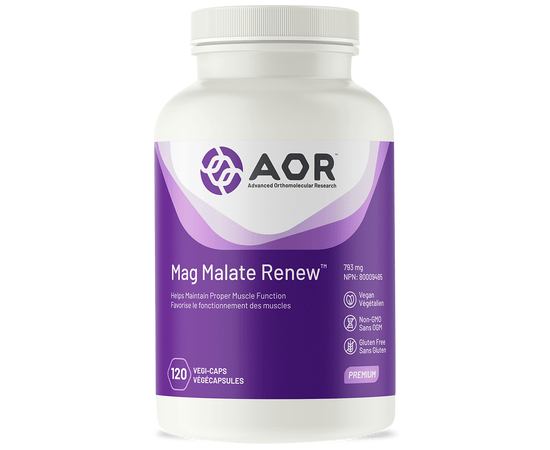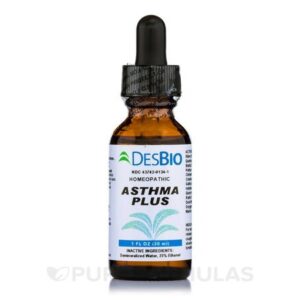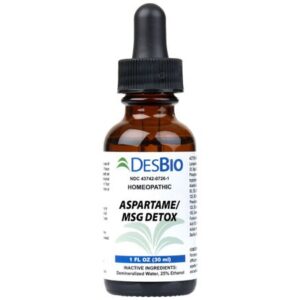Description
Details
Magnesium is a mineral that is involved in over 300 biochemical processes in the body. One of its most important functions is that it plays a key role in producing energy and maintaining muscle and nerve function. Unfortunately most people do not have sufficient levels of this essential mineral for optimal health. Studies suggest that 50-90% of people are deficient in magnesium.
Mag Malate Renew™ is a 100% pure combination of magnesium and malic acid. Malic acid is ionized in the body to form malate, which is a key intermediate in the energy production cycle that makes ATP, the fuel that allows cells to function. Low levels of ATP are commonly found in people suffering with fibromyalgia and are believed to play a significant role in the physical and mental symptoms of the condition. This has been confirmed in several studies which have found that magnesium malate reduces the symptoms of fibromyalgia and chronic fatigue such as muscle pain and brain fog.
Those who have been diagnosed with fibromyalgia or chronic fatigue may find some relief from its mental and physical symptoms using magnesium malate, as well as those who have not been diagnosed but have low energy levels and persistent fatigue.
The increased production of ATP also has promising implications for athletes, and some preliminary evidence is suggesting that magnesium malate may help improve endurance. In addition, athletes can also benefit from magnesium’s ability to help with proper muscle function.
AOR Advantage
Studies have found that the combination of magnesium and malic acid significantly reduces the symptoms of fibromyalgia. This combination may also be effective for relieving chronic fatigue syndrome. AOR’s Mag Malate Renew™ provides safe and effective relief for conditions of pain and fatigue.
Label Information
NPN
80009485
Discussion
Mag Malate Renew™ is magnesium malate. Magnesium helps maintain proper muscle function, metabolize carbohydrates, proteins and fats, and is a factor in the maintenance of good health.
Guarantees
AOR™ guarantees that all ingredients have been declared on the label. Contains no wheat, gluten, corn, peanuts, sesame seeds, sulphites, mustard, soy, dairy, eggs or any animal byproduct.
Adult Dosage
Take one to three capsules daily with food, or as directed by a qualified health care practitioner.
Main Applications
- Energy
- Chronic Fatigue Syndrome
- Fibromyalgia
- Muscle function
Disclaimer
The information and product descriptions appearing on this website are for information purposes only, and are not intended to provide or replace medical advice to individuals from a qualified health care professional. Consult with your physician if you have any health concerns, and before initiating any new diet, exercise, supplement, or other lifestyle changes.
Supplement FactsServing Size: One Capsule
Magnesium malate dihydrate
793 mg
— Elemental magnesium
100 mg
Non-medicinal Ingredients: microcrystalline cellulose, sodium stearyl fumarate. Capsule: hypromellose.
Research Facts
Superior Bioavailability of Magnesium Malate
In a 2019 study in rats comparing several magnesium supplements, the researchers found that magnesium malate provided the most bioavailable magnesium. Five different magnesium compounds (magnesium sulfate, magnesium oxide, magnesium acetyl taurate, magnesium citrate, and magnesium malate) were administered as a single dose 400 mg/70 kg to Sprague Dawley rats. Bioavailability was evaluated by examining time-dependent absorption, tissue penetration, and the effects on the behavior of the animals. Pharmacokinetically, the area under the curve calculation is highest in the magnesium malate. The levels remained high for an extended period in the serum. Magnesium oxide and magnesium citrate had the lowest bioavailability when compared to the control group. https://pubmed.ncbi.nlm.nih.go…
Chronic Pain & Fibromyalgia
Study 1:
In a 2005 pilot study, a proprietary tablet (Super Malic) containing 200 mg of malic acid and 50 mg of magnesium was tested as a treatment of primary fibromyalgia syndrome (FM). Twenty-four sequential patients with primary FM were randomized to a fixed-dose (three tablets bid), placebo-controlled, four week/course, pilot trial followed by a six month, open-label, dose-escalation (up to six tablets bid) trial. A two week, medication-free, washout period was required before receiving treatment, between blinded courses, and again before starting open-label treatment. The three primary outcome variables were measures of pain and tenderness, but functional and psychological measures were also assessed. Results: No clear treatment effect attributable to Super Malic was seen in the blinded, fixed low dose trial. However, with dose escalation and a longer duration of treatment in the open-label trial (up to six tablets twice a day for six months), significant reductions in the severity of all 3 primary pain/tenderness measures were obtained without limiting risks. https://pubmed.ncbi.nlm.nih.gov/8587088/
Study 2:
In a 1992 study, 15 fibromyalgia patients were given an oral dose of 300-600 mg of magnesium and 1200-2400 mg of malic acid for periods of four and eight weeks. The tender point index (TPI) scores (x±) were 19–6±2–1 prior to treatment and 8±1.1 and 6–5±0.74. respectively, after an average of 4 and 8 weeks on the magnesium malate combination (p < 0.001). Subjective improvement of myalgia occurred within 48 h of supplementation. in six FM patients, following 8 weeks of treatment, the mean TPI was 6.8 ±0.75. After two weeks on placebo tablets, the TPI values increased to a mean ± SE of 21.5 ±1–4(p < 0.001). Again, subjective worsening of muscle pain occurs within 48 h of placebo administration. https://www.tandfonline.com/doi/abs/10.3109/13590849208997961
Study 3:
A 2016 study published in the journal Pain Management suggests that low levels of magnesium and zinc in fibromyalgia patients may encourage a process called excitotoxicity, in which the neurotransmitter glutamate gets carried away and overstimulates those cells to death. https://www.futuremedicine.com/doi/10.2217/pmt-2016-0019
Cellular Energy Production
These enzymes form a series of pathways (glycolysis, Kreb’s cycle and phosphorylation) that convert organic compounds like glucose into smaller molecules called adenosine triphosphate or ATP. ATP acts as our main unit of cellular energy.
Malic acid is produced by the human body and it is a key player in the Krebs or citric acid cycle. This cycle includes the metabolism of carbohydrates, proteins, and fatty acids to create adenosine triphosphate (ATP). ATP is a complex organic chemical that provides cellular energy for all living organisms on earth. Magnesium act as a cofactor for enzymes involved in ATP production.
Based on the understanding of the roles of both malic acid and magnesium in the energy production process, magnesium malate is thought to increase cellular energy. An extensive review of the literature could not retrieve clinical study supporting that claim at this time.
Exercise Performance
Creatine malate – Malic acid is found combined with creatine supplements as creatine malate to improve the body’s absorption of creatine. Compared to the common creatine monohydrate, creatine malate is characterized by greater structural stability and greater resistance to gastric acid (and other digestive enzymes).
A 2015 study published in Acta Physiologica Hungarica, investigated the effectiveness of a creatine-malate supplement in sprinters and long-distance runners. After six weeks of supplementation combined with physical training, there was a significant increase in the physical performance in sprinters, measured by peak power, total work, body composition, and elevated growth hormone levels. In long-distance runners, there was a significant increase in distance covered. https://pubmed.ncbi.nlm.nih.gov/25804393/
Dry Mouth (Xerostomia)
Malic acid 1% mouth spray – Different clinical trials found that a malic acid 1% mouth spray may increase the production and flow of saliva. These studies suggest that this mouth spray may reduce dry mouth caused by blood pressure medications and antidepressants as well as dry mouth in the elderly. We do not know if the benefits associated to this oral spray can be extrapolated to a magnesium malate supplementation. https://www.ncbi.nlm.nih.gov/pmc/articles/PMC4867210/




